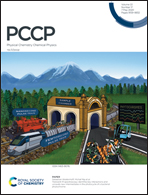Common cancer mutations R175H and R273H drive the p53 DNA-binding domain towards aggregation-prone conformations†
Abstract
The p53 protein is a tumor suppressor and the most often mutated protein in human cancers. Recent studies reported that p53 mutants, including two of the common cancer mutants (R175H and R273H), are more prone to aggregation than wild type (WT) p53 and their pathological aggregation can lead to diverse cancers. However, the underlying molecular mechanism is poorly understood. Herein, we investigated the structural and dynamic properties of R175H and R273H mutants of the p53 core domain (p53C) by performing extensive all-atom molecular dynamics simulations. We found that both R175H and R273H mutants exhibit a well preserved β-sheet structure, but a larger hydrophobic surface area and higher loop flexibility than WT p53C. These conformational properties are consistent with the structural features of aggregation-prone molten-globule states. Our data also provide the details on how the two mutations lead to an increased flexibility of loop2. Moreover, using dynamic network analysis, we identified the allosteric path through which the R273H mutation induces an increased flexibility of the distant N-terminal region of loop2. These results provide mechanistic insights into the high aggregation propensities of R175H and R273H mutants.



 Please wait while we load your content...
Please wait while we load your content...